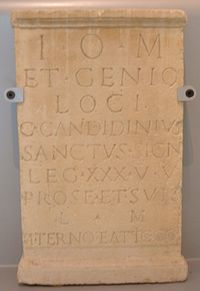Genius loci

The Latin term genius loci literally means “the spirit of the place”.
With spirit was in Roman mythology a guardian spirit originally ( Genius ) meant that often in the form of a serpent was depicted. In Roman antiquity, the term genius loci referred to religious places such as temples and places of worship as well as to secular areas such as provinces, cities, squares, buildings or individual rooms within these buildings.
In the tradition of monotheistic Christianity, the term spirit is defined differently, namely as a spirituality that cannot be precisely defined . In this sense, genius loci describes the spiritual atmosphere of a place, which is supposed to be shaped by the spirit of the people who have stayed there or are still there. For example, the genius loci of the Maulbronn monastery is a central theme in the works of Hermann Hesse (especially in Unterm Rad and Narziss und Goldmund ).
In architecture and spatial planning , the term also describes the structural specifications and features of a location, which can be decisive in determining the design. Because every property is initially defined by its location and the way it is embedded in its surroundings, from which it derives its value, its character and its possible uses. But the genius loci is not composed solely of the nature of the soil, the size of an area and other measurable factors, but also includes the atmosphere and aura of a place. In this sense, the genius loci is a construct in which knowledge, memory, perception and interpretation merge as an interpretive performance of the human mind. In order to achieve an unusual development with its own character and ambience, the genius loci is often included in the design process for a building. It plays an important role in architecture, especially when it comes to integrating historical buildings , when it comes to picking up the points of contact that a location offers and transferring them to the future, for example in the structural rededication of old church buildings. The more recent architectural theory strives for a systematic analysis of the connections between building and location reference.
In politics, the term stands for the symbolism of a place of negotiation where significant bilateral or multilateral agreements were negotiated or signed (e.g. the Hall of Mirrors in the Palace of Versailles ) or where other historically significant events took place (e.g. costly events Battles like at Verdun or Stalingrad ).
literature
- Christian Norberg-Schulz: Genius Loci. Landscape, living space, architecture. Klett-Cotta, Stuttgart 1982
- Reiner Götzen: Holistic project development in residential construction. Living worlds - a corporate strategy. Published by the Institut für Lebenswelten, ISBN 978-3-938666-52-4 .
Web links
- The spirit of the place or the spirit and its place. ( Memento from April 16, 2010 in the Internet Archive ) emmet 4–2008
- lexikon48.de
Individual evidence
- ↑ Tomáš Valena: Relationships: about the location reference in architecture . 1. updated & exp. Edition. Geymüller, Aachen 2014, ISBN 978-3-943164-14-5 .